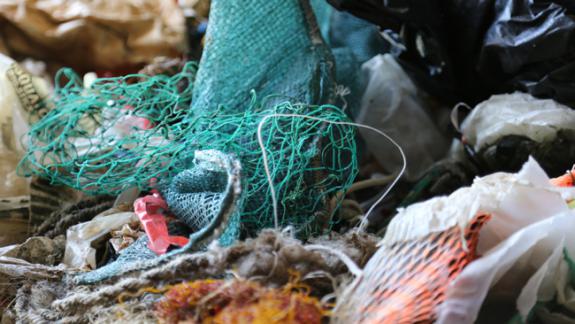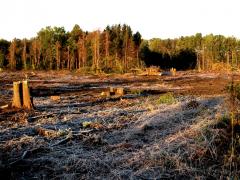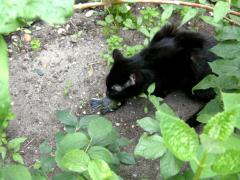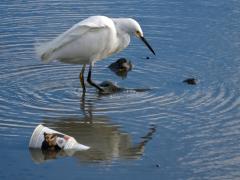Threats to Wildlife
Our wildlife face a variety of threats that test their ability to survive and reproduce. Wildlife are forced to either adapt to life with humans or face extinction.
 Ospreys use trash as nesting material because (sadly) it is a plentiful resource that collects in the upper areas of the saltmarsh. It is a deadly component of their nests that easily entangles them. Do your part and pick up litter if you see it. © Ben Wurst
Ospreys use trash as nesting material because (sadly) it is a plentiful resource that collects in the upper areas of the saltmarsh. It is a deadly component of their nests that easily entangles them. Do your part and pick up litter if you see it. © Ben Wurst
When we expand our territories, we invade wildlife’s territories. When forests are cleared and fields subdivided, wildlife is affected. Some species that can not evade bulldozers, like salamanders and turtles, may die outright. Others, like birds and some mammals, are forced into adjacent patches of habitat. That habitat may not be suitable for them to survive. Then we force our wildlife to navigate onto roads, across power lines, and around wind turbines.
- Habitat Loss
- Climate Change
- Invasive and Exotic Species
- Pollution
- Illegal Trapping and Poaching
- Accidental Deaths
The survival of every species of wildlife is critical to preserving our state’s rich biodiversity and unique natural history. Over time, we have altered our landscape to mostly benefit people and our civilization. We cut down forests for agriculture and housing developments, we introduce exotic species, and we change natural processes by releasing pollutants and greenhouse gases. The major threat to wildlife in New Jersey is habitat loss. However, wildlife face a variety of threats that include climate change, invasive/exotic species, pollution, illegal trapping, and accidental deaths.
 Zoom+ Habitat loss is the greatest threat to New Jersey's wildlife. © Kevin Sparkman
Zoom+ Habitat loss is the greatest threat to New Jersey's wildlife. © Kevin Sparkman
Habitat Loss
Habitat loss is the destruction of habitat. Habitat fragmentation is the degradation, destruction, or alteration of once continuous habitat when we alter and “chop up” the environment. Humans are the main cause for the loss of habitat. Wildlife that used to live there are usually displaced or killed. It is the leading cause for the loss of species from extinction.
The effects can be devastating. Gaps and breaks in large patches of habitat create suitable habitat for less desirable species and unsuitable habitat for native species. For example, in North America before European settlement the Brown-headed cowbird only occupied the Great Plains region. Today, its range has dramatically increased. Over time land use-land change practices fragmented forested habitat and created optimal cowbird habitat. Habitat fragmentation has allowed the cowbirds to expand their range to most of the continent south of the Arctic.
Habitat loss is the leading cause for the loss of species from extinction.
Many migratory songbird populations have declined because they are very susceptible to cowbird parasitism. Songbirds that nest in forested areas near cowbird habitat (open areas) are the most vulnerable. The cowbird is a generalist parasite (the female relies on other birds to raise its young). It lays its eggs in other smaller bird’s nests. Most birds can spot the different egg, but most do not notice and keep incubating. Generally, the cowbird’s egg hatches first (warblers’ eggs hatch in 12-14 days; cowbirds’ eggs usually hatch in 10-13). This slight advantage gives the cowbird nestling a head start. The cowbird nestling almost always outcompetes the other nestlings for food.
Climate Change
Climate Change or global warming is the overall increase in average temperatures on Earth. The rate of warming has increased dramatically due to the increased outputs of greenhouse gases (particularly carbon dioxide) since the industrial revolution. Its effects on wildlife are dramatic. Entire populations will be effected. Many species are already in jeopardy of becoming extinct, like the Polar bear. Other species will have to adapt to a warmer planet. It is believed that many ecosystems will shift north. Our climate in New Jersey will be like the climate in South Carolina if nothing is done to reduce our impact on our planet. Climate change may also significantly alter the chemical balance of the seas, off-shore currents, and plankton distribution and abundance, thereby affecting migration routes of marine species and impacting the entire food web.
 Zoom+ Outdoor and feral cats kill millions of birds each year, including rare species. © Marcel van Valen
Zoom+ Outdoor and feral cats kill millions of birds each year, including rare species. © Marcel van Valen
Invasive and Exotic Species
Invasive and exotic species are species that were introduced to North America that reduce biodiversity of native species. Many exotics were accidentally introduced during the colonial times when many plants (from other continents) were used as packing materials on ships. Animals from other continents may have also hitched a ride in those same ships or they were intentionally brought to North America. Invasive plants choke out natives and do not provide the same functions in the ecosystem. Exotic species can wreak havoc on native populations of wildlife by displacing them or altering their habitat.
Most exotics are able to quickly adapt to our environment. For example, house cats are not native and can have devastating effects on bird populations. Surveys have shown that only 35% of the known 77 million pet cats are kept indoors (American Bird Conservancy). Feral cats compete with native predators, reproduce quickly, and transmit disease. It is estimated that hundreds of millions of birds and billions of small mammals are killed by feral cats each year (American Bird Conservancy). Cats are opportunistic and kill a variety of birds. Common birds like Cardinals and endangered birds like the Piping plover all can fall prey to feral cats.
Pollution
Pollution is man-made waste or by-products that are released into the environment. Pollutants can change ecosystems and can have severe effects on people, wildlife and the natural environment. Many organisms ingest or absorb harmful toxins that ultimately get passed along through the food chain. Persistent pollutants, like DDT, PCBs, and heavy metals bio-accumulate (are stored in fat) in predators. All of the effects, especially over the long-term, are unknown. In many species bio-accumulation can be associated with reduced reproduction or death.
For example, the widespread and heavy use of persistent pesticides (DDT and DDE) in the 1950’s caused severe declines in many species of raptors. At the time, the effects of DDT on wildlife and the environment were unknown. It was quickly absorbed into soils and the environment and it was found to persist for a very long time. It caused egg shells to thin by inhibiting the production of calcium, which reduced their rate of reproduction. DDT is highly toxic to fish. It accumulates and gets concentrated through the food chain. When they were consumed by fish-eating raptors the DDT contributed to their decline. Since then, many pollutants have been banned in the U.S.; however, trace amounts are still found in many raptors and large fish.
Non-point source pollution can also have major impacts, but it is hard to measure because it comes from all across our landscape. When the rain falls and washes our roads clean, for example, the runoff carries car oil, metals, sediment, trace toxins, and litter (and even heat) down the storm drains and into nearby streams and rivers. It washes fertilizers, pesticides, pet waste and grass clippings from our lawns; farm fields give up soil, nutrients, and chemicals too. Fish spawning habitat may become smothered with silt. The extra nutrients and higher temperatures can cause oxygen-stealing blooms of algae and eutrophication in water bodies. Even the road salt that helps keep us safe in winter will accumulate in wetlands, causing problems for amphibians, aquatic animals, and plants. On the plus side, non-point source pollution is one threat we can all do something about, with a little care and education.
 Zoom+ Litter and trash pollute many of our lakes, rivers, estuaries, and oceans. © Ingrid Taylar
Zoom+ Litter and trash pollute many of our lakes, rivers, estuaries, and oceans. © Ingrid Taylar
Persistent marine debris, such as plastic bags and bottle caps, balloons, discarded fishing line, and medical waste threatens many forms of marine life. Such items may entangle and suffocate, drown, or otherwise restrict the movement of marine life or may be ingested and ultimately lead to the death of that animal. Such debris may take several hundred years to break down, thereby threatening wildlife for many years.
>> Read about debris that's collected from active osprey nests each summer.
Another form of pollution is noise pollution. Whales’ primary means of communication, navigation, locating food, locating mates, and avoiding predators and other threats is through their sense of hearing, which is much more highly developed than that of humans. Noise pollution created by ship traffic or offshore construction may negatively impact whales by disrupting their normal behavior. Active sonar, such as that used by the Navy, also threatens marine mammals by disrupting navigation, foraging and communication abilities. There have been instances of whale stranding and death caused by acoustic trauma. This may be due to a fatal injury within the structure of the ear, or may result from the distressed animal surfacing too rapidly and developing nitrogen bubbles within their blood (decompression sickness).
Wildlife trafficking is thought to be one of the most profitable illegal trades in the world.
Illegal Trapping and Poaching
Illegal trapping, poaching, and other demands for wildlife are a huge problem throughout the world. Many species are sought for their use as valuable products. Snakes are sought for their skins, elephants for their ivory tusks, and birds for their feathers. Wildlife are also trapped or taken from wild populations to be sold or bred in the pet trade. The worldwide demand for pets and medicinal products drives the illegal trade of wildlife, especially rare species. Sadly enough, wildlife trafficking is thought to be one of the most profitable illegal trades in the world.
 Zoom+ A female terrapin that was killed by a motor vehicle along Great Bay Boulevard in New Jersey. © Ben Wurst
Zoom+ A female terrapin that was killed by a motor vehicle along Great Bay Boulevard in New Jersey. © Ben Wurst
In many parts of the world, people kill wildlife for food or to protect their food source. Northern South America is where Ospreys winter. They catch and eat fish, sometimes from fish farms. People will shoot ospreys to protect fish farming operations in these areas where they are not protected. You can help protect Ospreys by not supporting fish that are farmed in these regions.
Accidental Deaths
Accidental deaths and collisions pose considerable threats to vulnerable species. An unknown number of deaths are caused by this worldwide. Accidental entanglement in fishing nets and collisions with ships pose major threats to marine mammals, especially whales. Vehicles strike birds and other wildlife when driving along roads. Large buildings, towers, and wind turbines also injure or kill many different species of wildlife.




